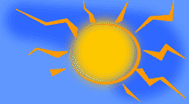It's hard to believe that it was in February that I last wrote when
we were still in Argentina. Since then we've sailed almost another 10,000 miles and it is with some surprise that I can say
Mithril made a record breaking voyage. We became the first Irish boat ever to visit South Georgia. Obviously lots of Irish
people have been there before us but never in an Irish registered boat so it was particularly appropriate that we arrived
on 16th March.
The next morning we were invited to a coffee party by the chief administrative officer and his wife. Home for them is
Shackleton villa a modern timber framed house - a bizarre combination of cosy suburbia and wilderness. Clannad played softly
from hidden speakers, cabinets held ornamental china and family photos in silver frames. There was even a tv in the corner.
At first glance the huge window by the tv looked like a framed black and white poster. Then you realised that the icebergs
were moving - drifting quietly out to sea. They had calved from the massive Cumberland glacier across the bay. The glacier
filled the valley like a rumpled blue-white blanket. The tall pointy mountains surrounding it had been dusted white by overnight
snow and the eerie gray light over the current scene suggested more snow soon. Back in Shackleton villa the party hummed along
and, even though it was only eleven o'clock in the morning, we got stuck into chocolate cake and wobbly coffee - made with
Jamesons in honour of the day. Only about a dozen people from the British Antarctic Survey overwinter on the island and I
think we met them all. It was all very jolly and - well - normal until you happened to glance out the window at the swirling,
feathery flakes of snow now sticking to the glass.
March is considered late in the summer season for visiting South Georgia with its Antarctic climate and when we woke
on 18th of March we found almost half a metre on snow on deck. "Unusual conditions, won't last", we were told. Next day there
was ice floating all around us and small icebergs in the bay at Grytviken. Among the ruins of the whaling station we eventually
found the coal store and this kept us warm while gales blew outside the cove and ice scraped the hull destroying the antifouling
and staining the ice red. Our berth was alongside the flensing plane where the carcasses were once butchered and processed
in vast pressure cookers. When the whalers last departed Grytviken they left everything in place for the next season; a season
which never arrived. It's fascinating, but eventually depressing, to wander among the decrepit buildings with their miles
of asbestos lagged steam pipes which once fed the factory and the wind moaning through the holes in roof. There are rusty
tools on broken shelves, birds nest in the mouldy cinema seats and at the back of the restored church library books await
their next readers.
The wildlife is awesome. A factory that was once a riot of blood and butchery is now an adventure playground for thousands
of fur seal pups. We found them sheltering inside pieces of pipe and under machinery in the gloomy workshops from where they
would growl menacingly at us. Out on the snow they chased us like irate terriers, snapping at our ankles. Apparently they
have a nasty bite but they don't like high pitched noises and rapping a piece of pipe on a bucket was enough to get them to
back off. From Shackleton's grave, which is marked by a block of rough hewn granite, we looked down on a group of male elephant
seals moulting in stinking, steaming piles. There are a few dozen king penguins in Grytviken which trumpeted at us as we passed,
their bills stretched to the sky. I sat on a length of snow covered pipe while Peter videoed them and within seconds two inquisitive
old gentlemen, almost a metre tall, shuffled over to prod insistently at my legs possibly looking for food but more likely
impressed by my bright red oilies. It was astounding I never expected to get this close to wild penguins. Up close their plumage
is stunningly beautiful; gray to blue black with vivid orange splashes at the neck and a pristine white front.
We did manage to visit a couple of the other whaling stations where we saw reindeer which were imported to feed the workers
and are now feral and have lost their migrating instinct. The stations are gradually disintegrating from age and neglect;
at Leith we could only watch as a building slowly collapsed under the weight of snow. After almost a fortnight the weather
showed no sign of thawing. We watched penguins skate over the pancakes of ice all around the boat and reckoned it was time
to head north rather than risk getting iced in for the winter. Next stop Carrickfergus 81 days and 8,000 miles northwards.

